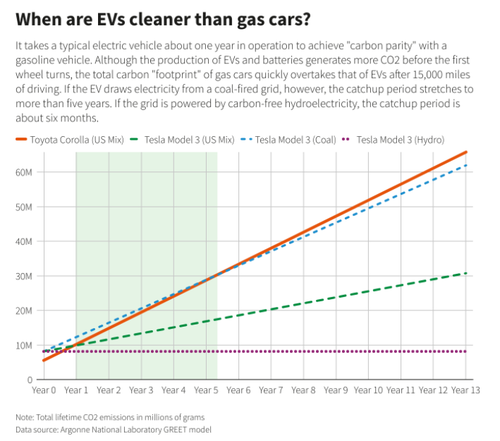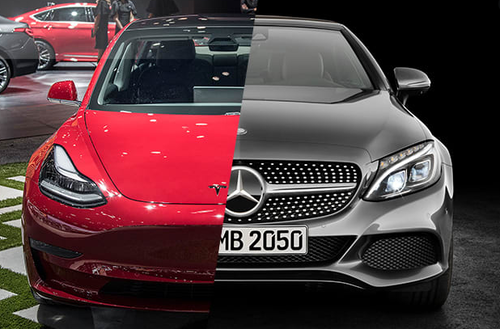EVs Must Drive Tens Of Thousands Of Miles Before Doing Less Environmental Harm Than Gas-Powered Vehicles
Most people don’t know it, but EVs are not as clean as gasoline cars right off the bat. In fact, due to the impact of mining many materials used in EV batteries, it takes quite a bit of driving before you are doing less harm to the environment than gas cars.
This was the topic of a new Reuters analysis piece by Paul Lienert, which sought to point out exactly how long you have to own and drive an EV in order to reach parity with a gas vehicle. The analysis was performed using “data from a model that calculates the lifetime emissions of vehicles” developed by the Argonne National Laboratory in Chicago.
The necessity for the analysis is obvious, because “…making EVs generates more carbon than combustion engine cars, mainly due to the extraction and processing of minerals in EV batteries and production of the power cells,” said Jarod Cory Kelly, principal energy systems analyst at Argonne.
The time it takes for how long EVs need to be driven to make up for that gap varies. It varies on factors “such as the size of the EV’s battery, the fuel economy of a gasoline car and how the power used to charge an EV is generated,” the analysis notes.
In a Tesla Model 3, for example, the article points out you’d need to drive 13,500 miles before you’re doing less harm to the environment than a gas powered car.
Reuters used the model, which took into account how power was generated in different countries to reach its conclusions:
Reuters plugged a series of variables into the Argonne model, which had more than 43,000 users as of 2021, to come up with some answers.
The Tesla 3 scenario above was for driving in the United States, where 23% of electricity comes from coal-fired plants, with a 54 kilowatt-hour (kWh) battery and a cathode made of nickel, cobalt and aluminum, among other variables.
It was up against a gasoline-fueled Toyota Corolla weighing 2,955 pounds with a fuel efficiency of 33 miles per gallon. It was assumed both vehicles would travel 173,151 miles during their lifetimes.
But if the same Tesla was being driven in Norway, which generates almost all its electricity from renewable hydropower, the break-even point would come after just 8,400 miles.
If the electricity to recharge the EV comes entirely from coal, which generates the majority of the power in countries such as China and Poland, you would have to drive 78,700 miles to reach carbon parity with the Corolla, according to the Reuters analysis of data generated by Argonne’s model.
EVs “generally” emit far less carbon than ICE vehicles over a 12 year life span, according to Michael Wang, senior scientist and director of the Systems Assessment Center at Argonne’s Energy Systems division.
The question then becomes – especially for vehicles like Teslas, which are notorious for quality control issues – can your EV make it to 12 years?
Analysis performed by Reuters using Argonne’s GREET model concluded that the “typical break-even point in carbon emissions for EVs was about 15,000 to 20,000 miles” depending on which country the vehicle is in. Other past analyses have been less optimistic. For example, University of Liege researcher Damien Ernst had said in 2019 that the “typical EV would have to travel nearly 700,000 km before it emitted less CO2 than a comparable gasoline vehicle,” before eventually revising his estimates lower.
The analysis follows last month when we published an article reporting that EVs may offer a negligible difference from ICE vehicles in CO2 emissions. It was the topic of a blog post by natural resource investors Goehring & Rozencwajg (G&R), a “fundamental research firm focused exclusively on contrarian natural resource investments with a team with over 30 years of dedicated resource experience.”
The firm, established in 2015, posted a blog entry entitled “Exploring Lithium-ion Electric Vehicles’ Carbon Footprint”, where they called into question a former ICE vs. EV comparison performed by the Wall Street Journal and, while citing work performed by Jefferies, argue that there could literally be “no reduction in CO2 output” in some EV vs. ICE comparisons.
Their analysis “details the tremendous amount of energy (and by extension CO2) needed to manufacture a lithium-ion battery.” Because a typical EV is on average 50% heavier than a similar internal combustion engine, the analysis notes that the “embedded carbon” in an EV (i.e., when it rolls off the lot) is therefore 20–50% more than an internal combustion engine.
Tyler Durden
Thu, 07/01/2021 – 13:03
via ZeroHedge News https://ift.tt/2UjSA0d Tyler Durden

